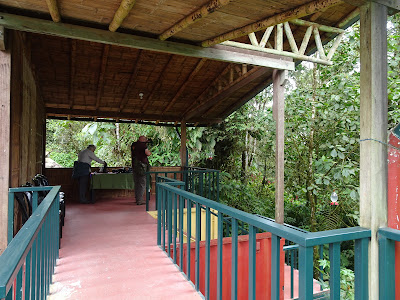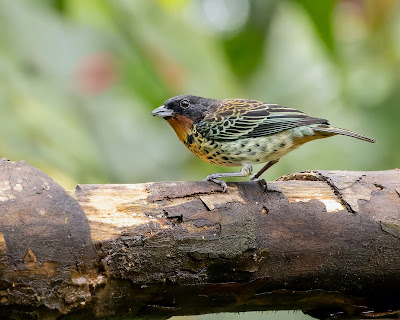Tuesday, September 14, 2021
(Teri) We were up in the van by 5:30 am this morning. We took our breakfast with us and ate it on the 2-hour drive to Milpe Bird Sanctuary.
Milpe opened in 2004. It’s a 247 acre montane evergreen forest on the Western Andes Range. The entry fee was $12 each.
When we arrived there were hummingbirds everywhere! There was also a banana feeding station that was very popular for other birds. We stayed around the feeding stations for quite a while before walking down the road. The road was nice and dry.
The trails were very muddy and a little overgrown.
About 1:00 pm we ended up at the Milpe Gardens where we had our box lunch. Carne asada with rice, banana, chips, and Oreo cookies.
There were more hummingbird and banana feeders here and it was hard to quit looking at birds long enough to eat.
The birding platform was built high into the trees where we had some interesting views looking down at the hummingbirds.
We arrived back at the lodge around 3:30. We relaxed, birded out on the back deck and got back together at 6:00 to update the bird checklist. Dinner started with chicken and rice soup then a strange meal followed – chickpeas with something (I can’t even try to explain it) over toast and a weird bright green smear (I’ll have a picture of this unusual green splatter in the next blog). A bowl of white rice rounded out the meal.
Tuesday, 9/14/2021 (Mark) – Got up at 5:00, and in the van by 5:30 for the drive to Milpe Bird Sanctuary. The very first thing we saw was a group of hummingbird feeders absolutely swarming with different hummingbirds. Lots of White-necked Jacobins which we hadn’t seen up to this point, along with many Green Thorntails and Crowned Woodnymphs.
Adjacent was a great set of fruit feeders, which attracted a number of tanagers, including Golden-naped, Golden, Black-capped, Dusky-faced, and Rufous-throated Tanagers.
Also enjoying the bananas were three different types of toucans and both male and female Red-headed Barbets. Some really fantastic looking tropical birds!
From the feeders we took a walk back down the entrance road where we picked up a nice variety of birds, including a Roadside Hawk soaring overhead and a perched Blue-tailed Trogan.
At 10:30 we walked down to what had been a Club-winged Manakin lek (display area) but found nothing there. José mentioned that some researchers had been allowed there to mist net and band the birds over a period of time, and he thought that disturbance had displaced the birds. Too bad.
We walked some forest trails and picked up a few more species, including great looks at a Brown-billed Scythebill, a woodcreeper with a wonderfully long, curved bill.
We ended up at another area called Milpe Gardens, where we found yet another set of busy hummingbird and fruit feeders. We ate lunch on a raised platform while watching the feeders.
I had a hard time getting my lunch eaten as I was constantly jumping up with the camera to take pictures as various birds came and went.
We left about 2:00 and arrive back at our lodge at 3:15. Took a short nap and then met the others for a bird countdown and dinner.
Next time: Upper Tandayapa Valley
































Looking at all the hummingbird pictures, it seems to me they might be the most difficult to identify as there seems to be so many different color patterns. What are your thoughts about the most difficult birds to identify?
ReplyDeleteHey Randy- Another interesting question. Overall I'd say flycatchers are the toughest. There are hundreds of species, and most are shades of green/yellow/grey with subtle distinctions and (often) few field marks. For many you need to hear them call or sing to confidently make an identification. There is a group (Empidonax) in the US that are just brutal to ID. So we generally just, ahem, overlook them!!
DeleteI sure enjoy all the menu entries! We so rarely see hummingbirds from above - these all look very shiny from that angle. Do you know if that is the norm?
ReplyDeleteMost hummingbird had iridescent plumage, and if the sun is hitting it at the right angle they do shine like this. I guess that shooting from above makes that happen!
DeleteNormally I don’t write a lot about the food. This lodge advertised themselves as having this fabulous chef and the food was supposed to be amazing. I found the food very odd. I told our guide that they should let Junita do all the cooking. She was this delightful older woman from the area. She looked like she could make some authentic Ecuadorian food!
ReplyDelete